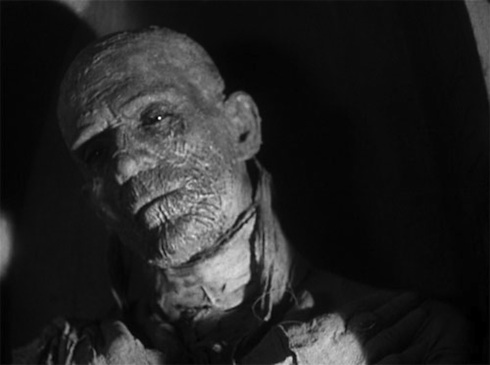Doubtlessly, generations of people have been directly or indirectly corrupted and confused about both archaeology and Egyptology by the 1932 film The Mummy. Learning about Egyptian history from this movie would be like trying to make Jell-O without a refrigerator. But on top of historical misrepresentations there’s another oddity about this classic monster. The bandage-clad, limping monster of our cultural imaginations isn’t really the focus of the original Mummy film, nor is that image even the predominant theme. Instead, Karloff’s mummy only does the bandage thing once and doesn’t so much as limp, but rather strides through what is a rather odd entry into the classic monster movie canon.
The film opens with three members of a 1921 British archaeology expedition arguing about whether clay pots are more interesting than mummies and if they should open a special little casket they recently excavated, as it might contain a super-rare and possibly magical scroll. The potency of spells and how strong certain spells may or may not be is central to controversy about opening the special little box and reading the magical scroll. Here we meet Dr. Muller, a character who essentially exists in several other forms in many of these other films.
In talking about both Frankenstein and Dracula, I have probably been remiss in not mentioning the presence of an actor named Edward Van Sloan. Van Sloan played Dr. Waldman in Frankenstein, and Van Helsing in Dracula. Here, as Muller he serves a similar role as he did in previous films: the wise-old expert with a kind of German accent who seems to know the score and is constantly warning the more American-seeming characters not to do stupid shit.
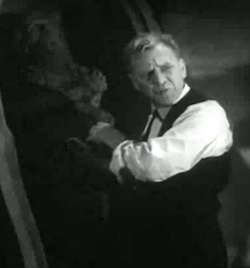 In The Mummy, Muller tells his eager archaeologist compatriots to hold their collective horses on opening the box with the scroll, because the spell will definitely screw all of them. They’ve deduced that Imhotep (Boris Karloff) was sentenced to death not only in this life, but also in the next life too, AND he was buried alive, meaning whatever he did to deserve this must have been pretty bad. The secret scrolls indicate that “death is but a doorway” meaning Imhotep thinks coming back to life will be pretty easy.
In The Mummy, Muller tells his eager archaeologist compatriots to hold their collective horses on opening the box with the scroll, because the spell will definitely screw all of them. They’ve deduced that Imhotep (Boris Karloff) was sentenced to death not only in this life, but also in the next life too, AND he was buried alive, meaning whatever he did to deserve this must have been pretty bad. The secret scrolls indicate that “death is but a doorway” meaning Imhotep thinks coming back to life will be pretty easy.
When left alone, however, Ralph (Bramwell Fletcher), the younger member of their party, opens the box and reads the scroll out loud. This wakes Imhotep up from his centuries long mummy-nap, and he proceeds to shuffle over and snatch the scroll. Ralph totally loses it at the sight of the walking corpse and when his boss, Joseph Whemple (Arthur Byron) returns, he starts sputtering: “He went for a little walk; you should have seen his face!” There’s something delightful about the way supporting characters crack up in these old monster movies and like Fritz and Renfield before him, Ralph’s laugh of insanity helps to set the tone for the rest of the film.
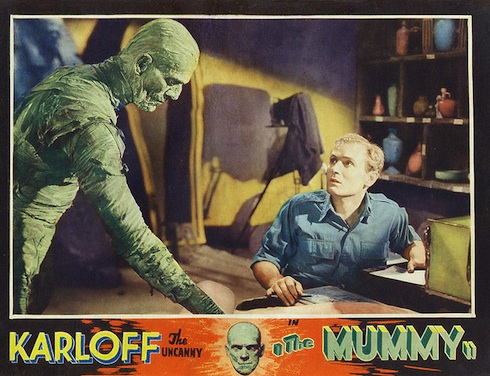
Flash-forward and it’s ten years later. Now Joseph Whemple has brought his son with him, the alpha male of this movie, Frank. (Shockingly, played by David Manners, whom we last saw as the bro “John” in Dracula!) Karloff is rocking a cane now, and has traded his bandages for some robes and a fez. He’s going not by the name of “The Mummy” nor “Imhotep” because I guess he doesn’t want to tip his hand just yet. (I like how Dracula was just like “I’m Dracula, deal with it.” I guess I prefer a straight fight to all this sneaking around.)
Anyway, his new name is “Ardath Bey” and he’s now decided to give the non-Egyptian archaeologists a tip as to where they could score a really good mummy, since apparently they couldn’t keep their hands on the last one they found. This provides the movie with its main plot element; Imhotep has given these guys the location of the tomb of the Princess Acnk-es-en-Amon, who was once his lady way back when he was alive in ancient Egypt. Not-surprisingly, a contemporary woman by the name of Helen bears a resemblance to ol’ Anck-es-en and as the tomb is uncovered, Imhotep starts hatching his scheme to covert Helen into a mummy imbued with the spirit of his old girlfriend.
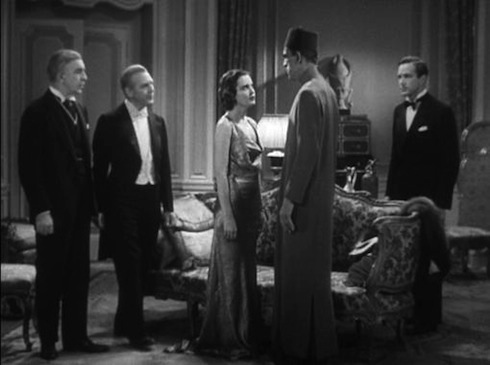
Looked at from almost every angle, this film has the exact same plot as Dracula. Dead guy with powers of mind control wants to turn an attractive woman into a living-dead creature like himself. Luckily, a moronic hunk is aided by a guy with a weird faux-German accent in a quest to stop the dead guy! With Manners in the role of Frank and Van Sloan as Muller, it seems like producer Carl Laemmle Jr. had something of formula here. This isn’t necessarily a bad thing, and Karloff’s Imhotep is arguably a more sophisticated monster than the creature from Frankenstein or Count Dracula. Because the guy was killed in such a horrific manner, there’s a degree of sympathy we feel for Imhotep that doesn’t just come from the basic perverse pleasure of rooting for the monster. In essence, despite there being formulaic feeling emerging from these kinds of films, there was an of attempt in The Mummy to do something a bit more subtle, maybe even understated. Does it work? For the most part yes, but it suffers from over-emphasizing its false-Egyptian aesthetic and the lack of a basic understanding as to the kind of monster we’re actually supposed to fear.
Perhaps this has to do with the fact that The Mummy was not derived from a work of novel-length literature like Frankenstein or Dracula. The most literary sources for the story are often linked to the Arthur Conan Doyle (non-Holmes) short story “The Ring of Thoth,” which deals with pseudo-supernatural mummies too. However, screenwriter John L. Balderston doesn’t seem to be directly influenced by it, as the original story was based on a treatment called Cagliostro, which dealt with a centuries-old magician who lived in San Francisco. It seems it was actually Balderston’s idea to move the action to Egypt. So where does the story of the Mummy come from? The answer seems to be a lot of different places, and this, coupled with some of the formulaic tendencies makes The Mummy resemble more of a contemporary big-budget Hollywood film than maybe any of the other classic monster films.
(You can read an extensive history of the making of The Mummy and its sequels here on Tor.com.)
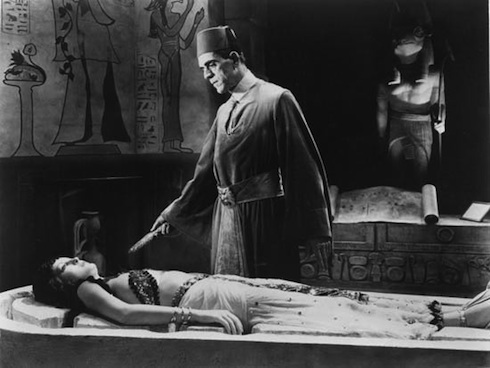
As in Frankenstein, Karloff’s performance more than makes up for any of these nagging shortcomings, and the fact that he’s doing all of this with very little make-up is actually great. The final scenes revolve around Imhotep preparing to run Helen through with a stone knife in order to create vessel for his love to live again. However, it turns out that Acnk-es-en-Amon’s spirit, when partially merged with Helen’s isn’t so sure about this plan. Just before being sacrificed, Helen/Anck-es-en apologies to Isis, which seems to turn the tide against Imhotep. Frank and Muller’s timely arrival seem to have practically no bearing on the defeat of “the mummy” insofar as Helen/Acnk-es-en seemed to have it all in check. This, too, is a nice deviation from the formula of the other films, and though it’s subtle, it is the sort of thing that makes the movie unique. But as Imhotep’s skin melts off and he descends into a pile of bones, one can’t help but hope that Karloff won’t return someday, all wrapped up in the bandages we came to associate with this iconic monster.
Karloff never did play the Mummy again, and unlike some of the other famous monster movies, no direct sequels were made. Of course various remakes and sequels to those remakes have surfaced over the years, making the legacy of The Mummy in some ways almost larger than the film itself. Even non-Mummy films seemed influenced by the imagery and notions of this movie. You can’t watch the scenes of shovels in the Eygptian desert and not think of Raiders of the Lost Ark. And Imhotep’s boast about coming back to life: “death is but a doorway” was reused by none of than Vigo the Carpathian in Ghostbusters 2. For a mess of bones on the ground who never got to strut around in his bandages for longer than a few minutes, the mummy may be the most immortal monster of them all.
Ryan Britt is the staff writer for Tor.com.










